|
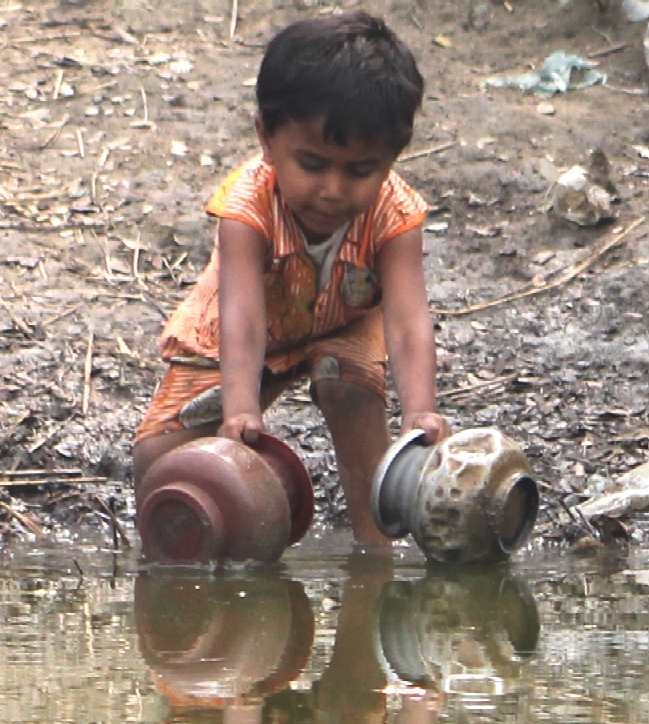
It's
still done like this in countries all over the world
Water
is essential to life, for drinking, washing and heating. We take it for
granted in developed countries, but then you should try surviving from a
water hole. I have. I raised water by hand using buckets and rope, just
as millions of people still do in undeveloped lands. I know that a
modern well takes us one stage further
and a well pump and storage tank, brings us into the 20th Century. You
can see the stages of reconstruction of a traditional well head below.
WATER
FOR LIFE
A water well is an excavation or structure created in the ground by digging, driving, boring, or drilling to access groundwater in underground aquifers. The well water is drawn by a pump, or using containers, such as buckets, that are raised mechanically or by hand.
Well, that was in days gone by. These days an electric pump linked to a
float switch does the job.
Wells can vary greatly in depth, water volume, and water quality. Well water typically contains more minerals in solution than surface water and may require treatment to soften the water.
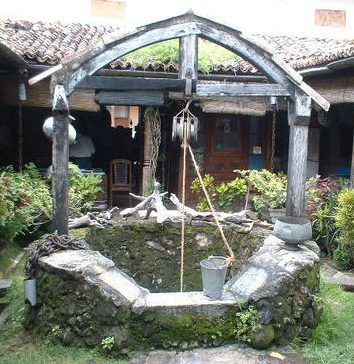
A
very old well head - Galle, Sri Lanka
OLDEST WELLS
The world's oldest known wells, located in Cyprus, date to 7500 BC. Two wells from the Neolithic period, around 6500 BC, have been discovered in Israel. One is in Atlit, on the northern coast of
Israel, and the other is the Jezreel Valley.
Wood-lined wells are known from the early Neolithic Linear Pottery culture, for example in Kückhoven (an outlying centre of Erkelenz), dated 5090 BC and Eythra, dated 5200 BC in Schletz (an outlying centre of Asparn an der Zaya) in Austria.
Australian Aborigines relied on wells to survive the harsh Australian desert. They would dig down, scooping out sand and mud to reach clean water, then cover the source with spinifex to prevent spoilage. Non-Aborigines call these native wells, soaks or soakages.
Stepwells are common in the west of India. In these wells, the water may be reached by descending a set of steps. They may be covered and are often of architectural significance. Many stepwells were also used for leisure, providing relief from the daytime heat.
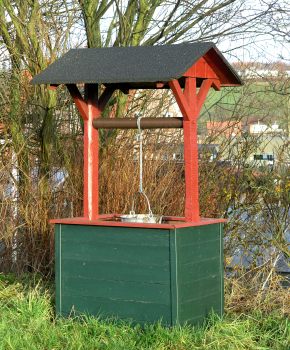
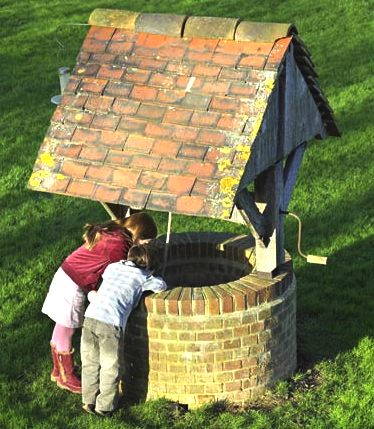
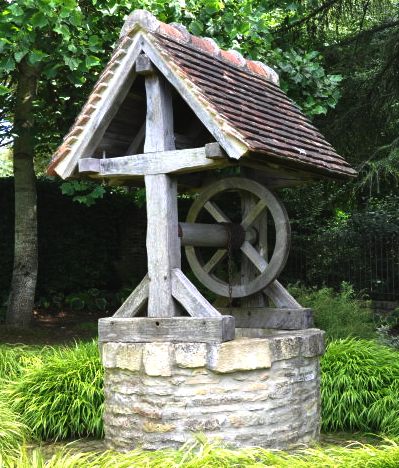
The
above are more fine examples of traditional well-heads from around the
world.
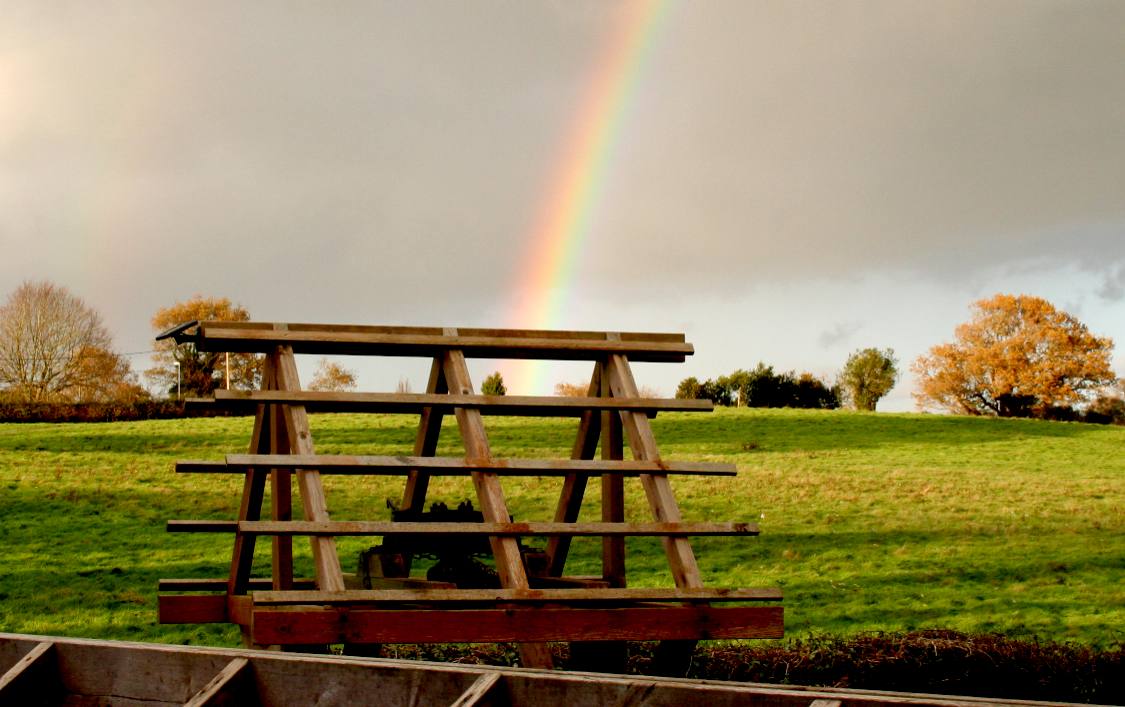
25
NOVEMBER 2015 - Is there is a pot of gold at the end of this rainbow or
is this a sign from above of good things to come? Herstmonceux Museum is
the home of innovation in much need of some TLC. Our curator had been
doing some roof repairs, trying to beat the rain on a chilly afternoon and this beautiful
sight suddenly appeared in between the dark clouds passing overhead.
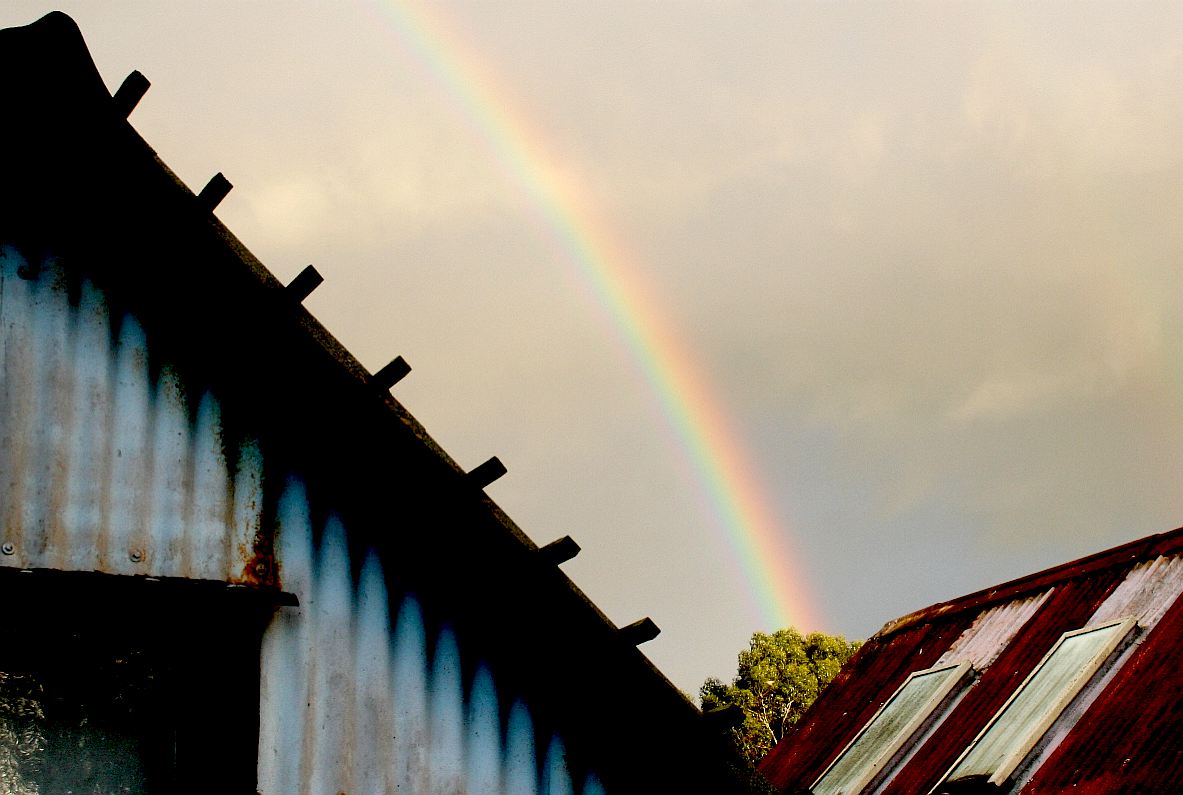
25
NOVEMBER 2015 - The rainbow went from the well on one side of the
building to the other side, forming a complete arc across the site. It
was a sight to behold and one that proved difficult to capture with an
ordinary lens. The museum needs a new roof, but at the moment the
building generates no income for repairs and the position is unlikely to
change - with a council that refuses to admit that they got it wrong as
to the obvious historic value of this unique site in Sussex. The Trust
also need to take down the WW2 corrugated iron and repair the timber
wall underneath.
WELL
RECONSTRUCTION - SUSSEX ENGLAND
A well in Herstmonceux in Sussex was rediscovered in 1982, and although
put back into use immediately, for the last fifteen years all that had
been done to preserve it is the rebuilding of the brick head and the making of a
wooden hatch cover - to
among other things prevent people and objects falling in.
In
June of 2013 a draughtsman got to work designing a suitable frame;
producing the drawings below from which to work to. They went through
several gestations until finally the scale seemed right in the context
of an estate that dated from C. 1800.
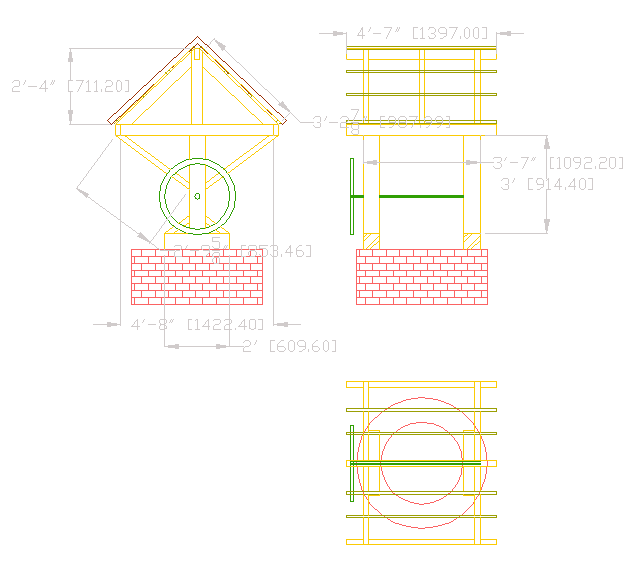
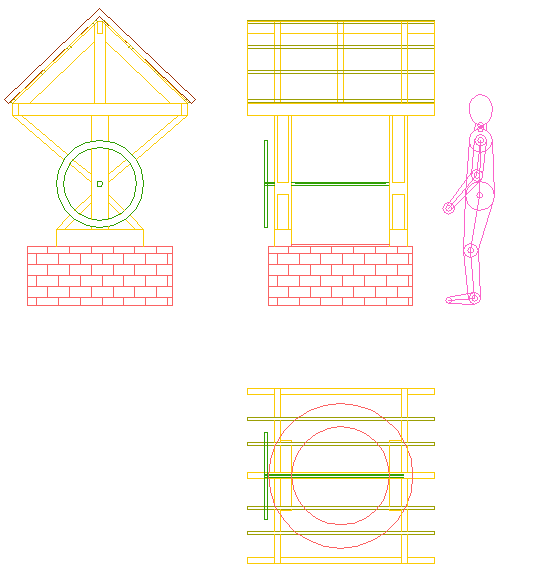
Restoration
in progress June 2013 - A well head at Herstmonceux Museum, Sussex, England.
The
bell for this well is dated 1898. During the re-build some slight modifications
were necessary to the timber framework. The height was raised by 3"
and the roof was lengthened. The 6" timber uprights were slotted
into the base timbers with a hand cut mortise and tenon joint
3"x3" using chisels and drills as seen below.
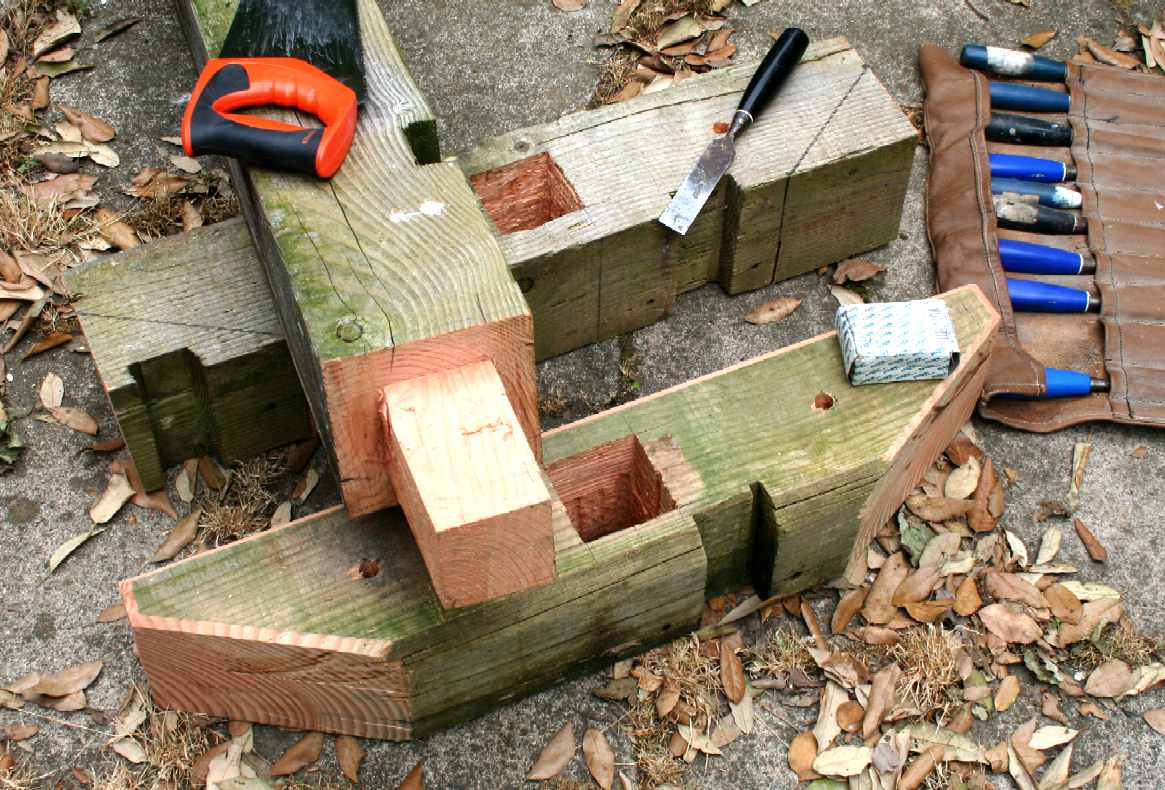
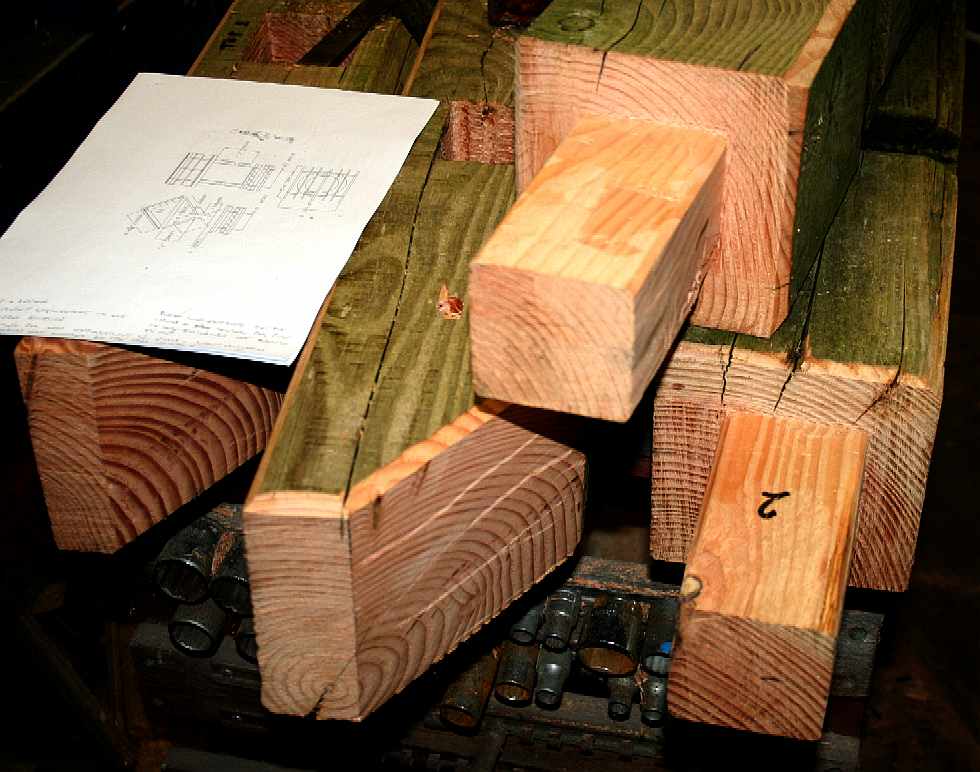
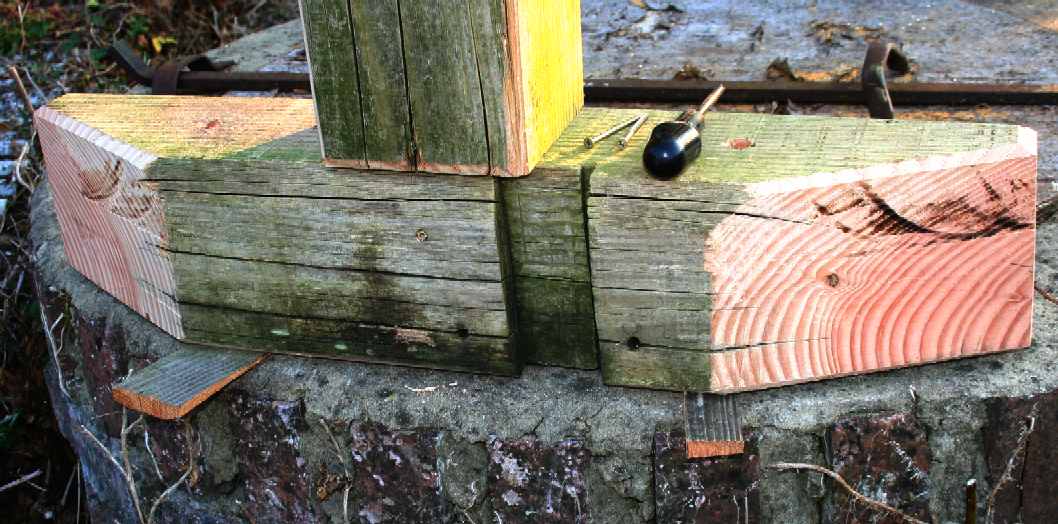
These
old timbers had lain around on site for some 30 years waiting for their
time to be carved into the frame for the well roof. Timbers of this size
take time to cut and shape. The same skills as the shipwrights of old
are employed
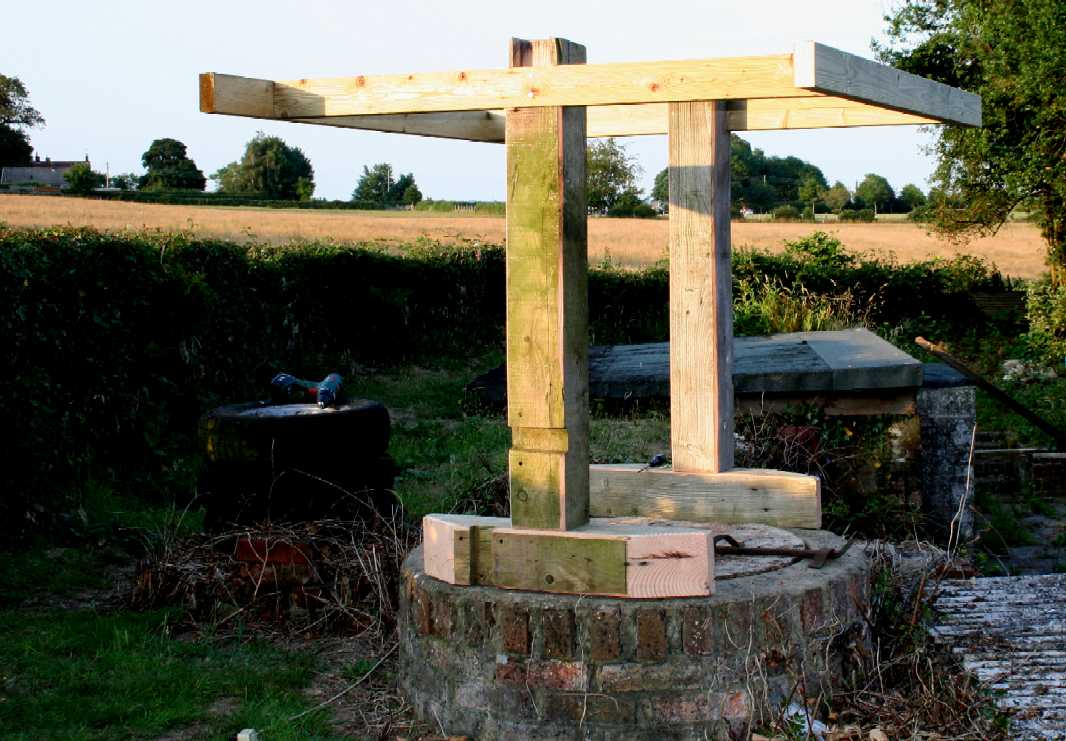
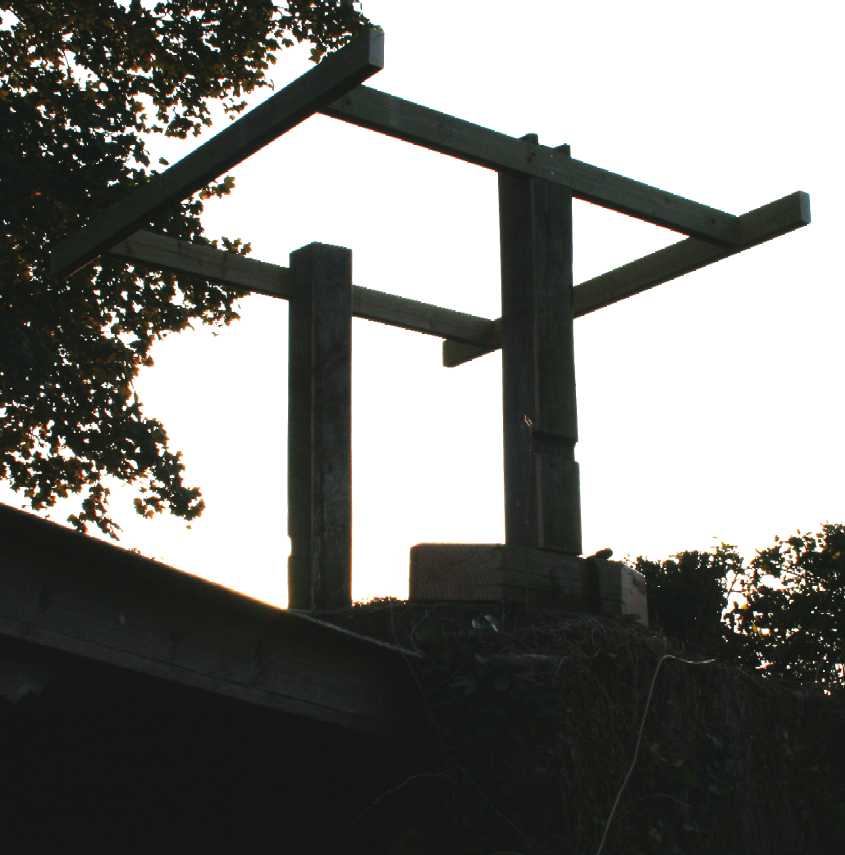
Restful
view of the Sussex countryside at Herstmonceux - an area of outstanding
natural beauty (AONB), and an iconic 'Roman' silhouette of the well roof taking
shape as seen from the courtyard below. Herstmonceux Museum was
listed on an English Heritage Monument Protection Programme from 2003.
The Trust that manages this site get no help from English Heritage or
the National Lottery towards the considerable cost of restorations. This
is the only working well in the village - used daily for water supplies.
it has been in use since before Augustus Hare lived in Lime Park (C.
1830).
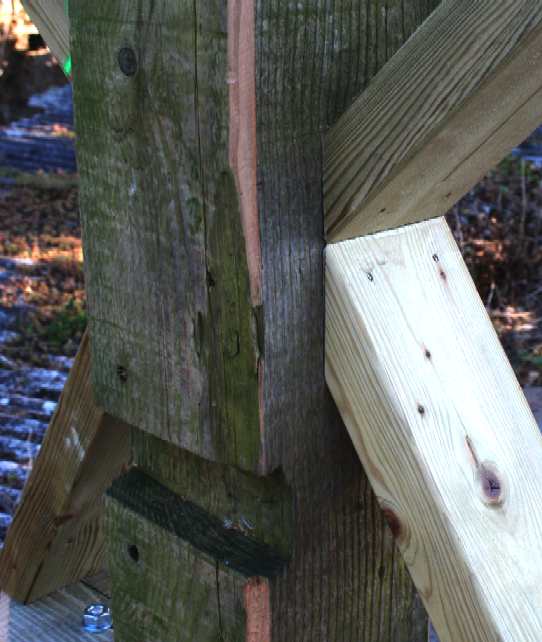
Detail
picture of the base triangulating support timbers. These are important
to stabilise the structure in high winds.
Similar cross bracing is used to support the longitudinal roof timbers,
known as purlins when used in the roof of a house - you can see the roof
cross bracing in the pictures below.
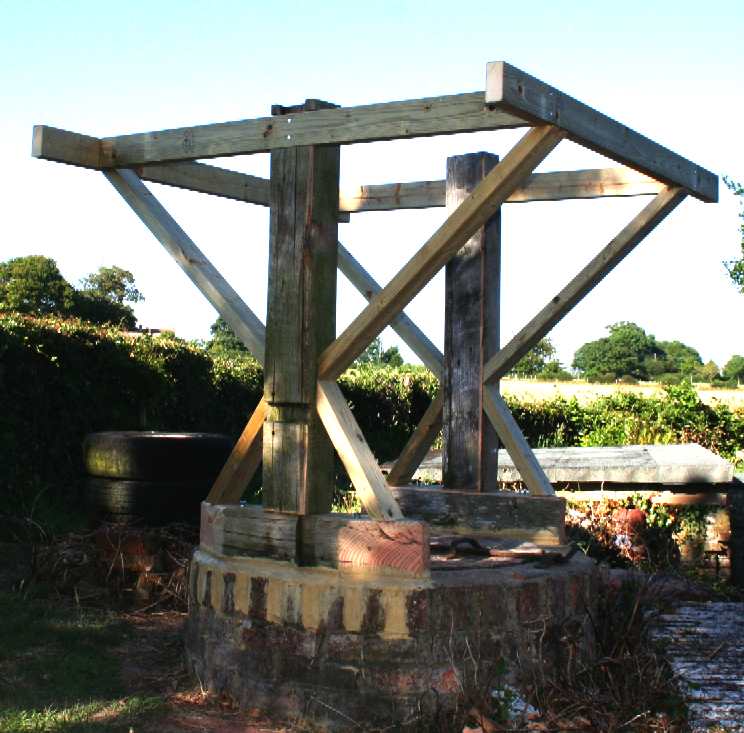
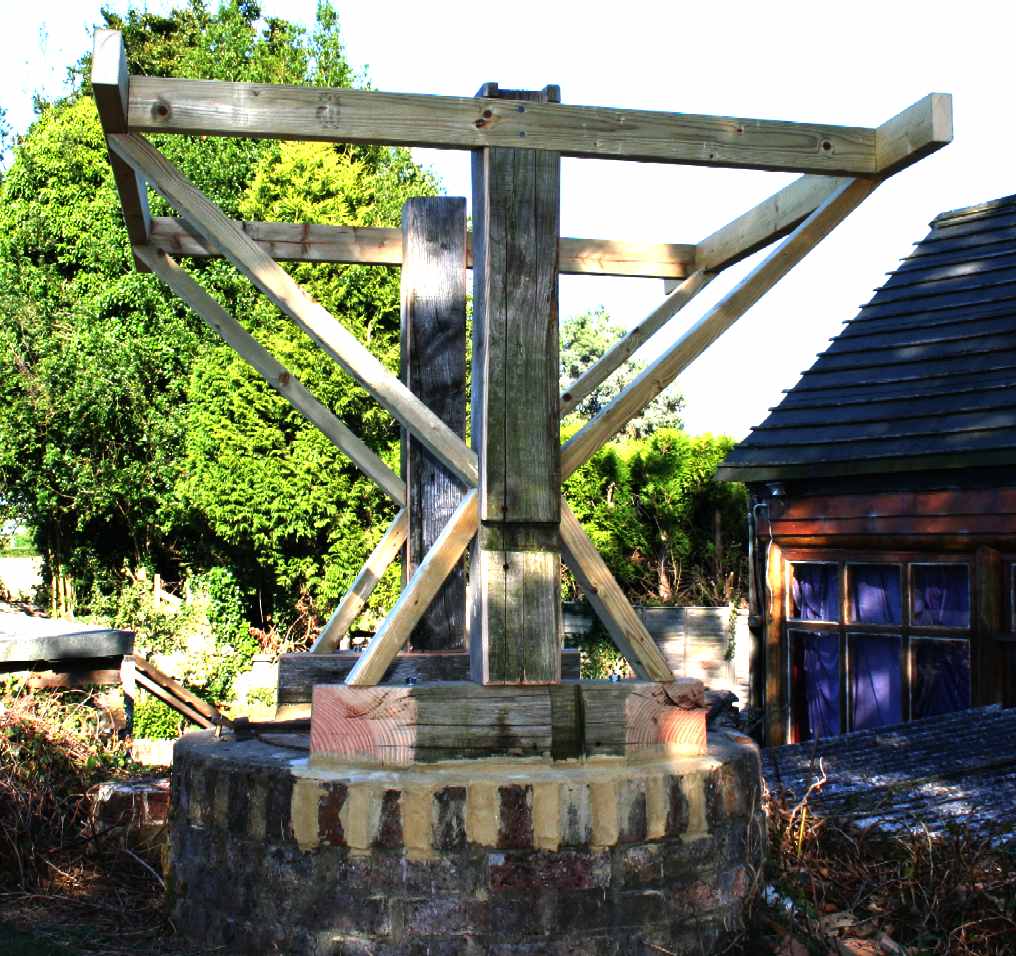
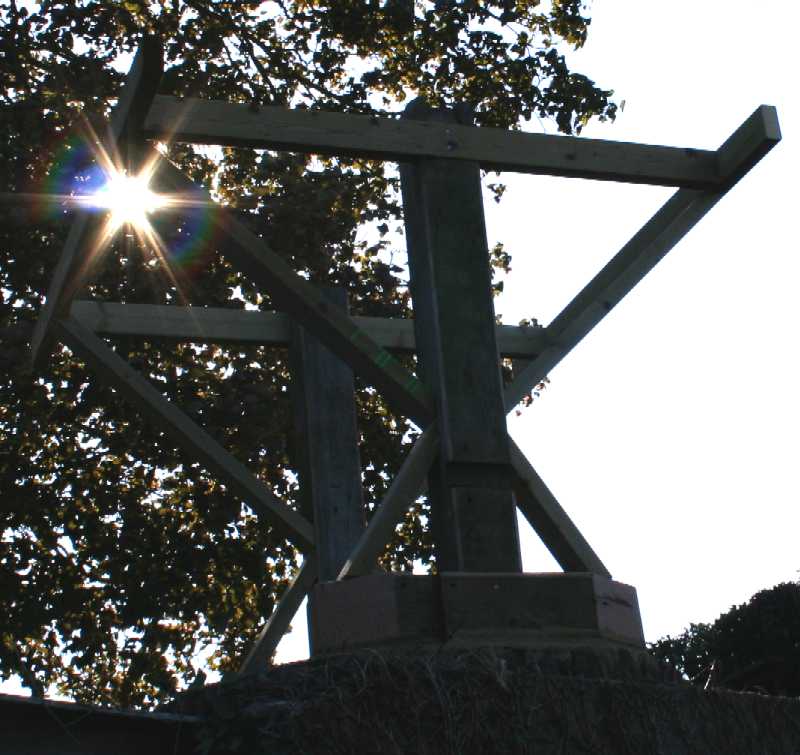
Sunshine
pours through an adjacent sycamore tree, blessing the structure.
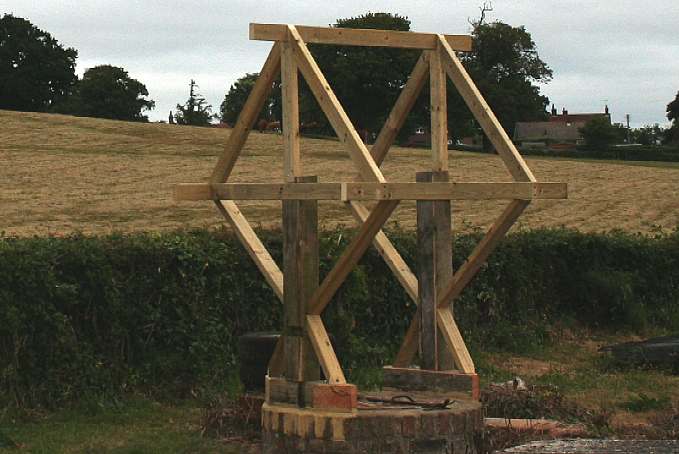
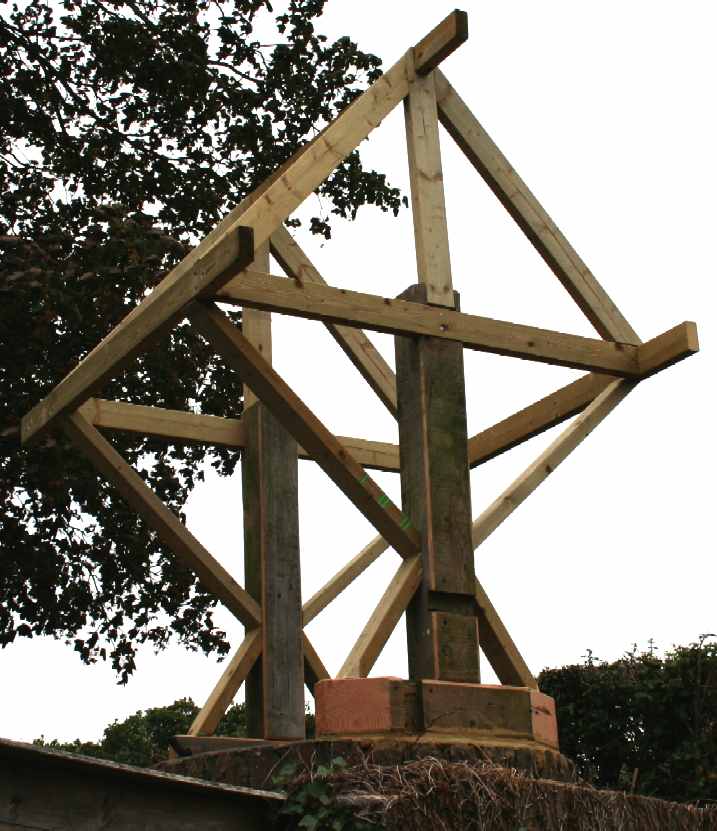
Four
timbers supporting the ridge beam, two more to go. The well is taking
shape. The ridge beam was raised a further 6" over and above that
raised already, another incremental improvement
on the original drawings above, to increase clearance for the well bell.
If you need a well head built, the builder of this structure will be
pleased to suggest a design and quote for the construction for your
dream house. This well feeds a raised storage tank via a three stage
single phase pump. The pump is controlled via a bespoke magnetic sensor,
in turn feeding from a float, made from an old soda-pop bottle attached
to a thin stainless-steel wire arm (316 grade welding rod). The magnetic
sensor switches a Maplin solenoid operated relay to amplify the signal
for 240 volt switching. Simples
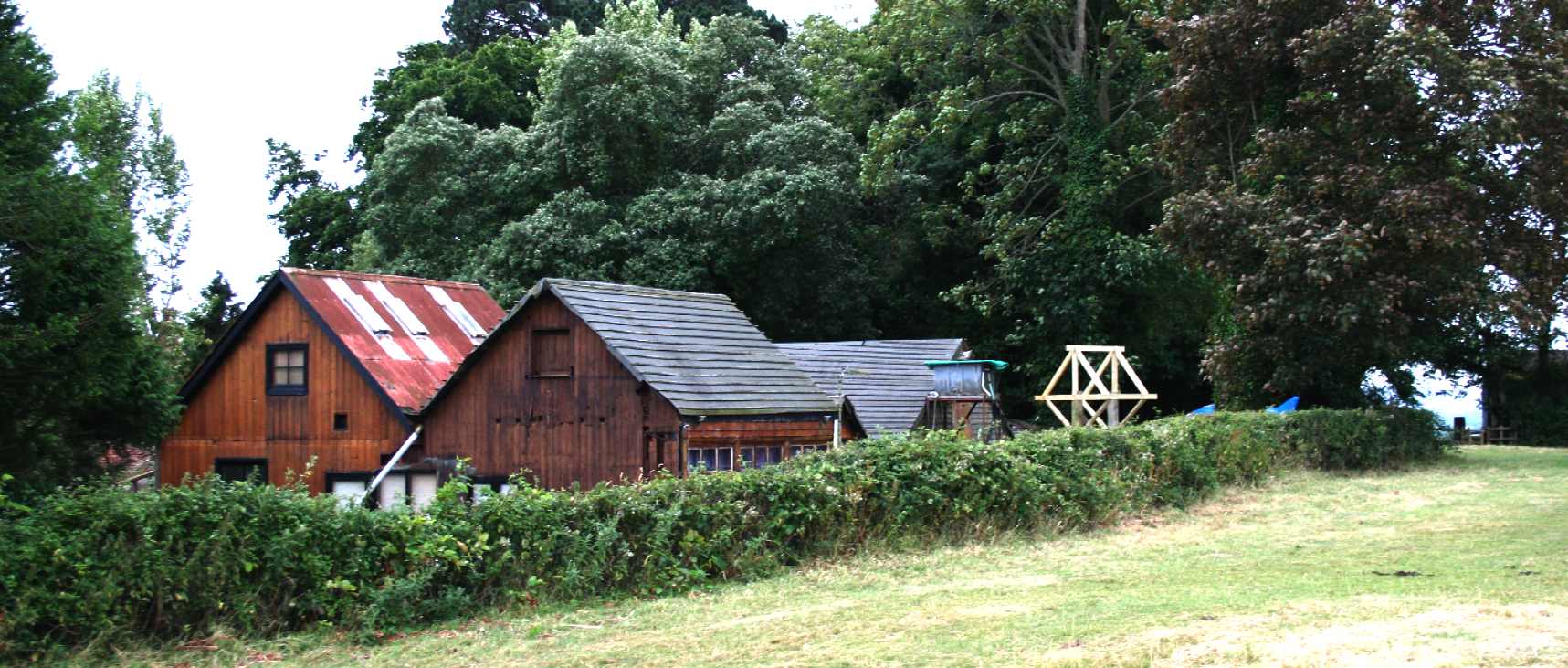
Panoramic
view of the well in context with the generating buildings that it has served
since long before C. 1900 - seen from the adjacent field, looking from Herstmonceux
village. The well reconstruction is part of the restorations planned for
this unique turn of the century wooden building. A wind turbine is to be added and a solar
conservatory. Not of course on the roofs of the historic section of this
building. The
idea is to blend new and old, and breath life back into a building that
was decommissioned as an electricity utility in 1936. A truly
sustainable experiment.
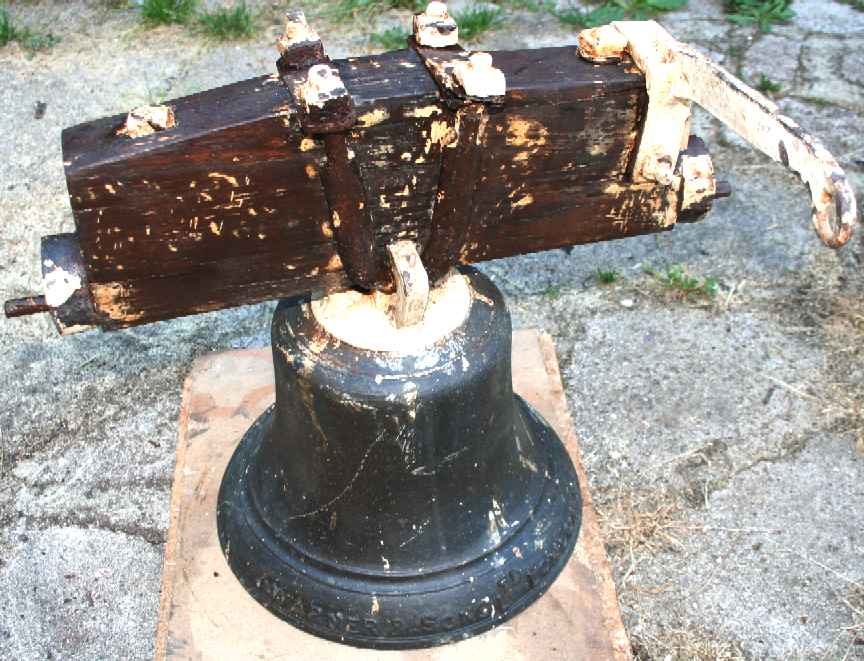
No
well is complete without a bell. This is the original bell found on site
in 1982, tucked away and long forgotten. It was in a sorry state, with
white paint flaking off and some metal parts crumbling to rust. The oak
yoke was sanded back to wood and the loose rust removed. Then the timber
was liberally treated with lashings of preservatives. All the moving metal parts were
soaked in WD40 then greased.
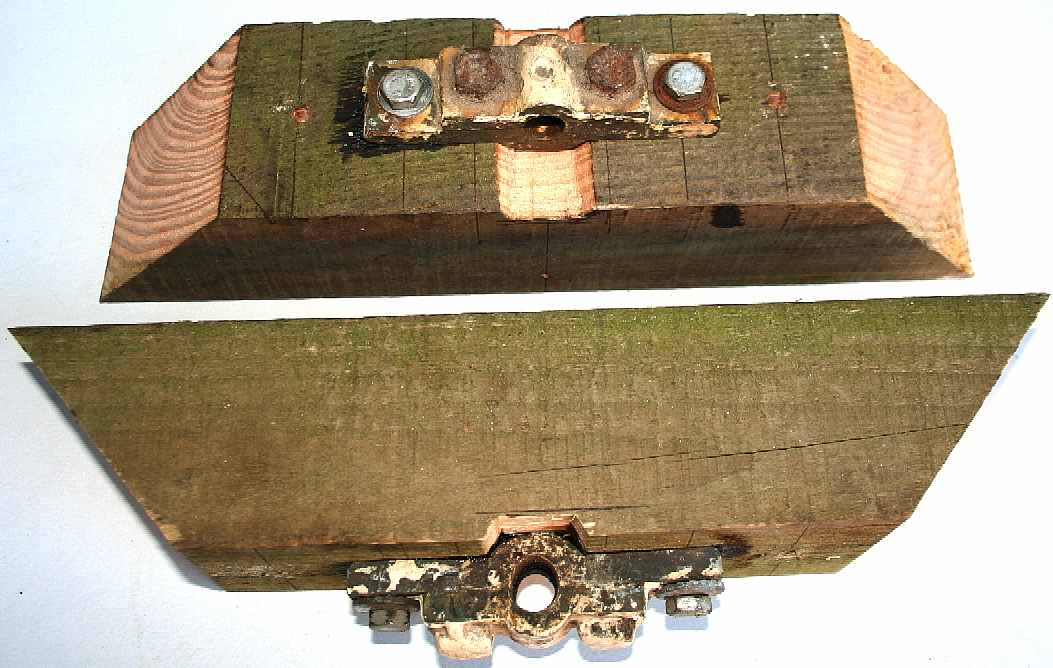
Next
we needed to make two bearing carriers, to attach the brass bell bearing
blocks, which assembly is in turn fitted to the main beam carriers that
go across the two low purlins. Treated 3" x 3" timber was
used. Recycled of course from old garden gate posts that had rotted away
at the base. The rotten ends were cut off to reveal sound wood.
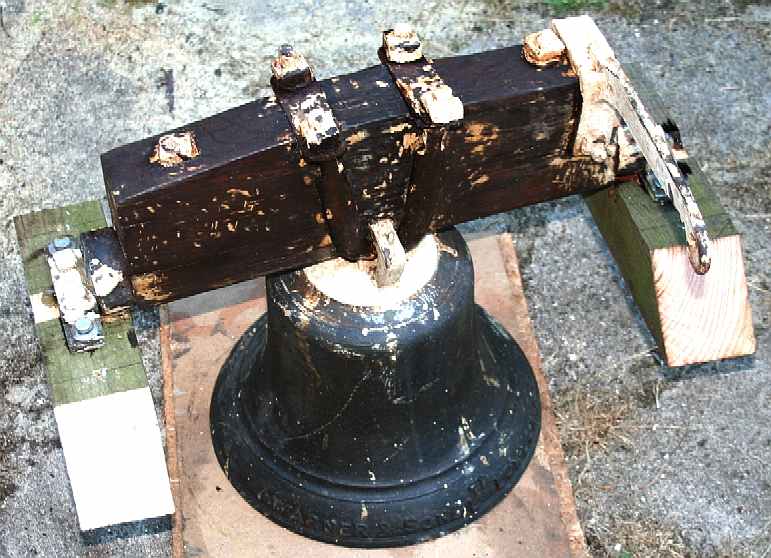
The
bearing carrier blocks are test fitted to the well yoke. Don't try to
fit a heavy item like a bell without first making sure that everything
fits at ground level.
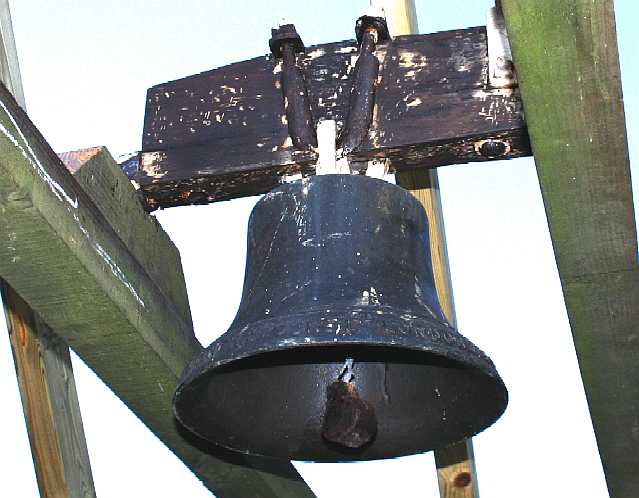
The
bearing carriers are bolted to the beams supporting the bell. Once
again, mark and drill everything accurately at ground level, before
fitting up high. Our carpenter uses a builders leather belt to carry a hammer, tape
measure, nails, set square and pen/pencil, with plenty more spare
pockets for pliers, screwdrivers and anything else to get the job done.
We still have the roof and a beautiful cast iron well wheel to fit.
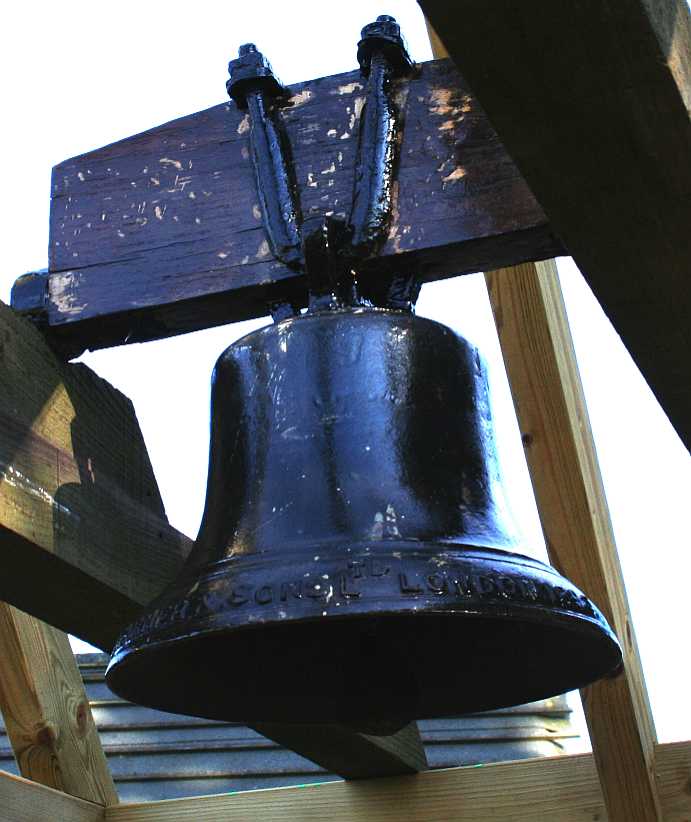
The
yoke has been treated with preservative against woodworm, wet & dry
rot. The ironwork has been oiled and painted with two coats of black and
the oak yoke has been varnished. Rather than polish the bell, we thought
we'd simply clean her up and give her a protective coat of lacquer that
could easily be removed without damaging the bronze, should the need
ever arise. The bell is after all an antique.
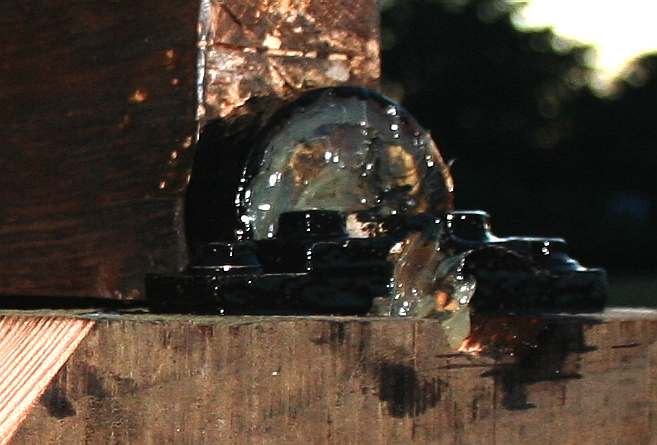
The
bearings are greased liberally. Once the roof is on, it's unlikely that
you'll want to poke your head in the belfry too often - that is why a
lot of bell towers are ruined.
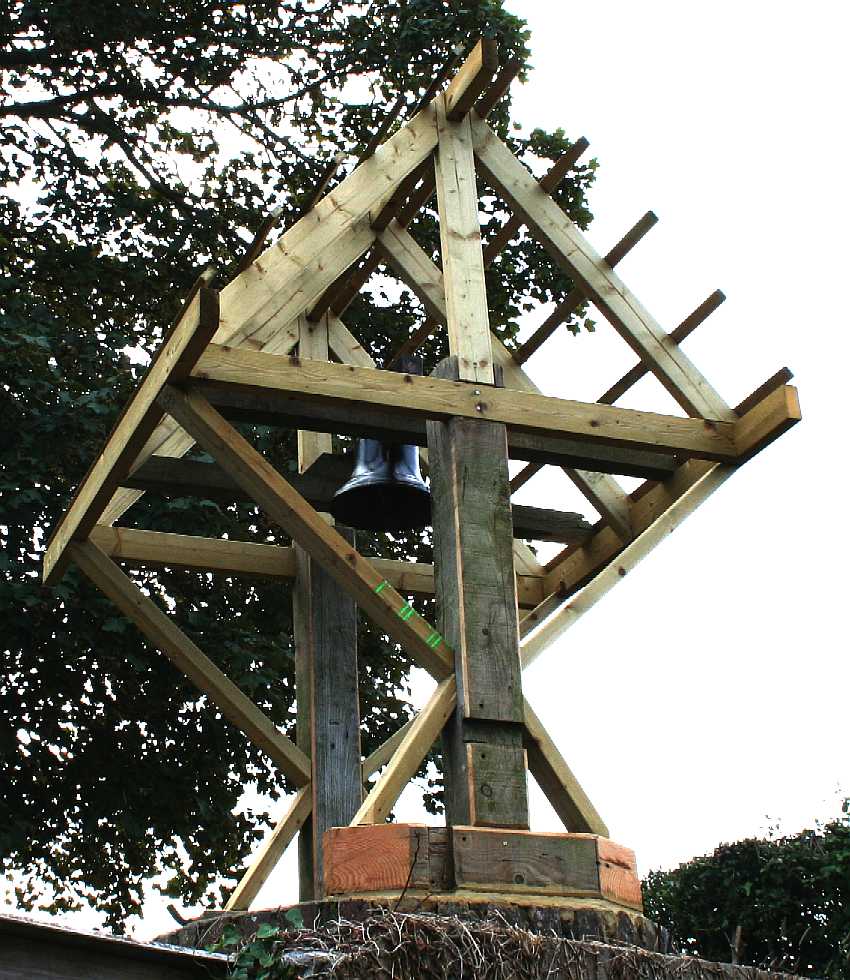
Once
the workings are installed and operable, the roofing proceeds with
fitting of treated battens. The well head looks a bit like a
mini-house. The roof will most probably have tiles (or slates)
eventually. For now though we are going to recycle some of the
corrugated iron that had been used to clad the generating buildings
during World War II.
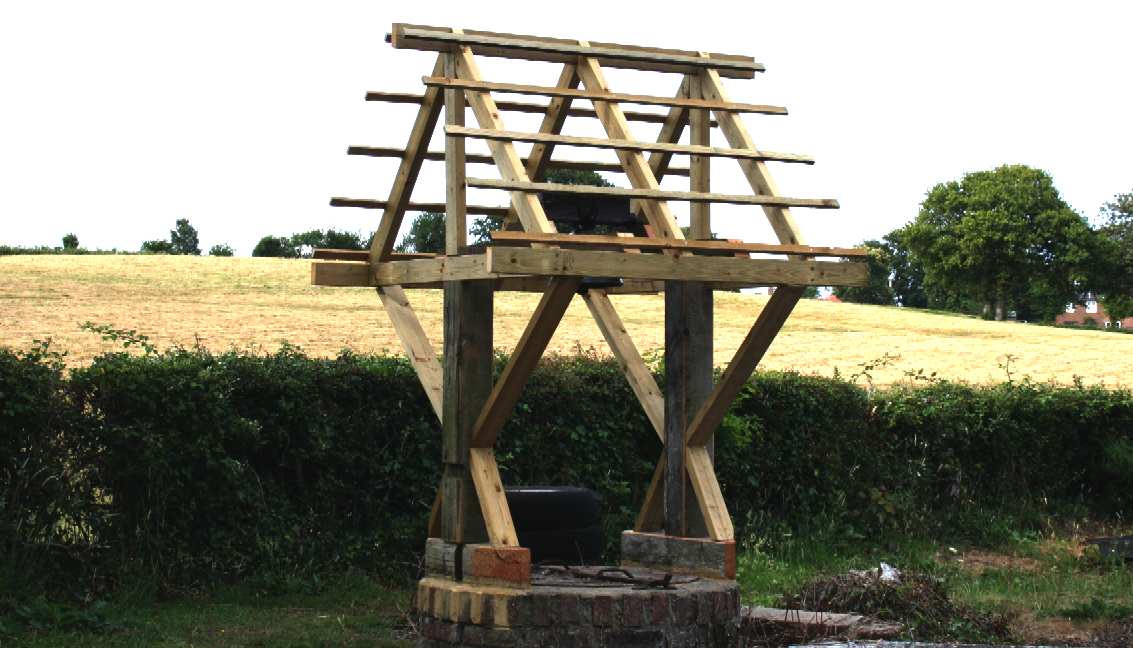
She's
starting to look like something, blending into the Sussex scenery as if
she'd never gone. We are looking forward to fitting the well wheel as
time allows. We will
treat all of the timber frame eventually, even though the new timbers
are tanalised. This structure is going to last another 150 years.
Walkers from the village (Cuckoo Trail) have been commenting on the work done so far.
Very encouraging.
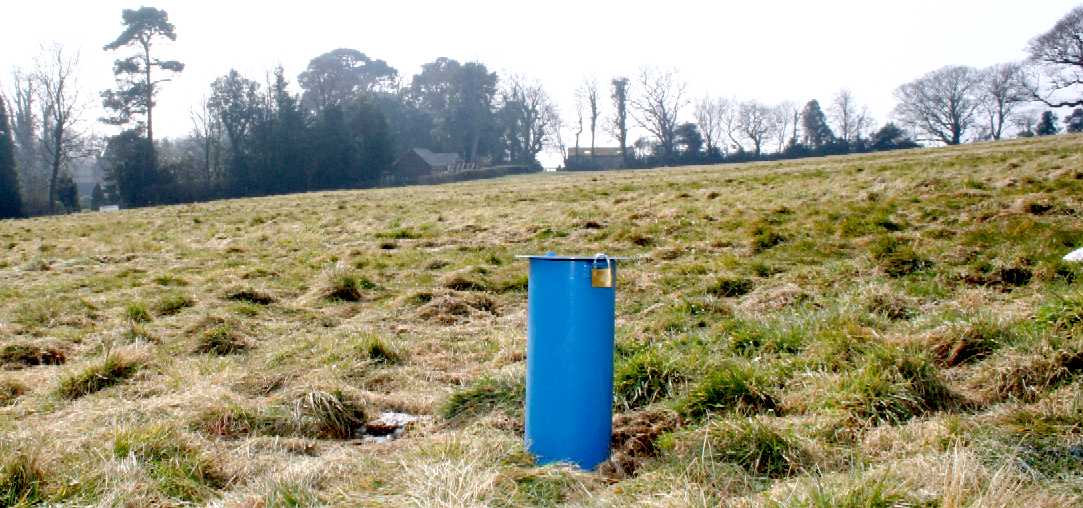
DRINKING
WATER CONTAMINATION - You can see from the levels in this photograph
that the ancient well used by Herstmonceux
Museum for all of its water supply is subject to contamination that
will arise if houses are built above the water table. If you check out
the plans for the proposed application from December 2014 and January
2015 (they are identical save for the name of the applicant) you will
see that houses are suggested on the slope leading to the Museum. It is
thus inevitable that the water supply to this unique heritage asset will
become contaminated if the proposed development is allowed to proceed.
Herstmonceux Museum is the building above and to the left of the magic
blue mushroom in the foreground.
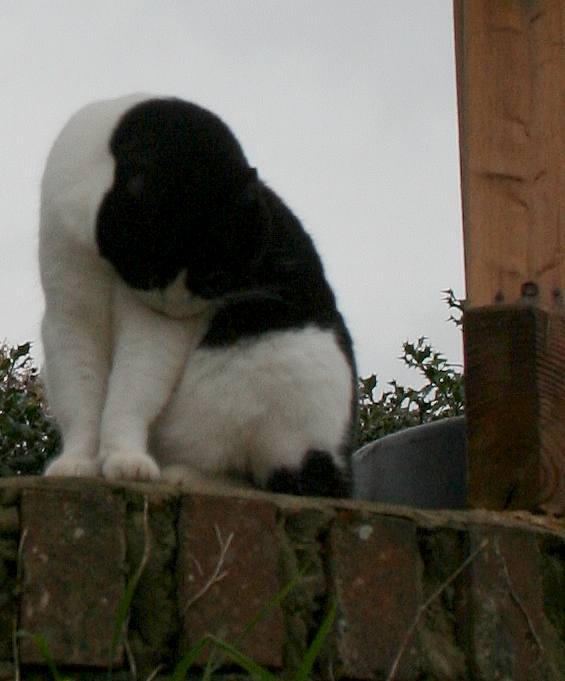
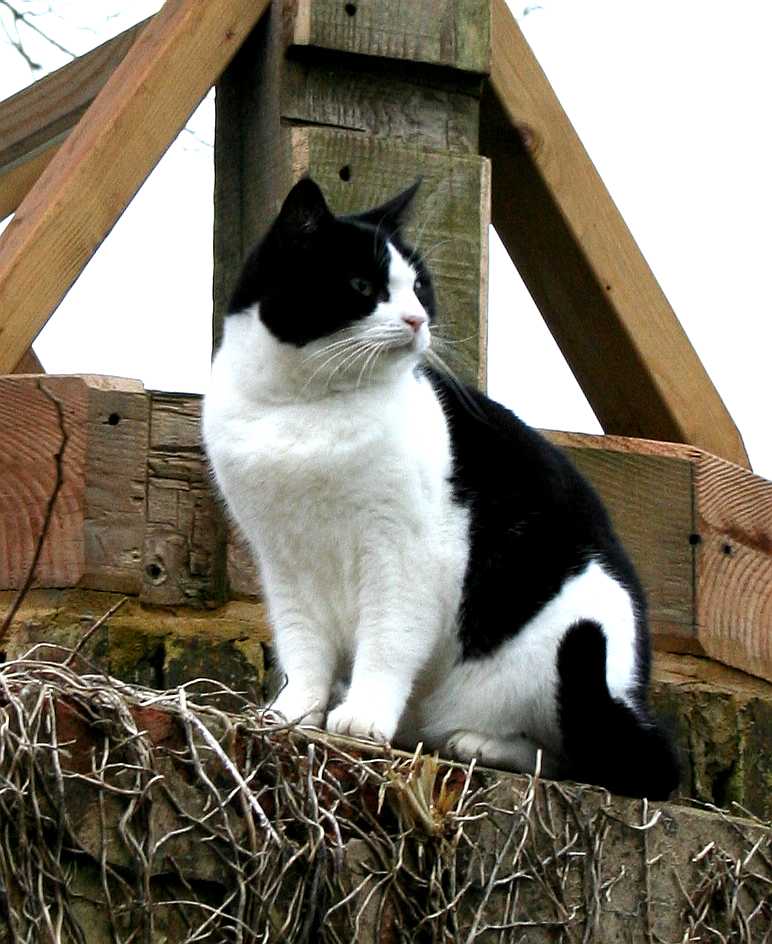

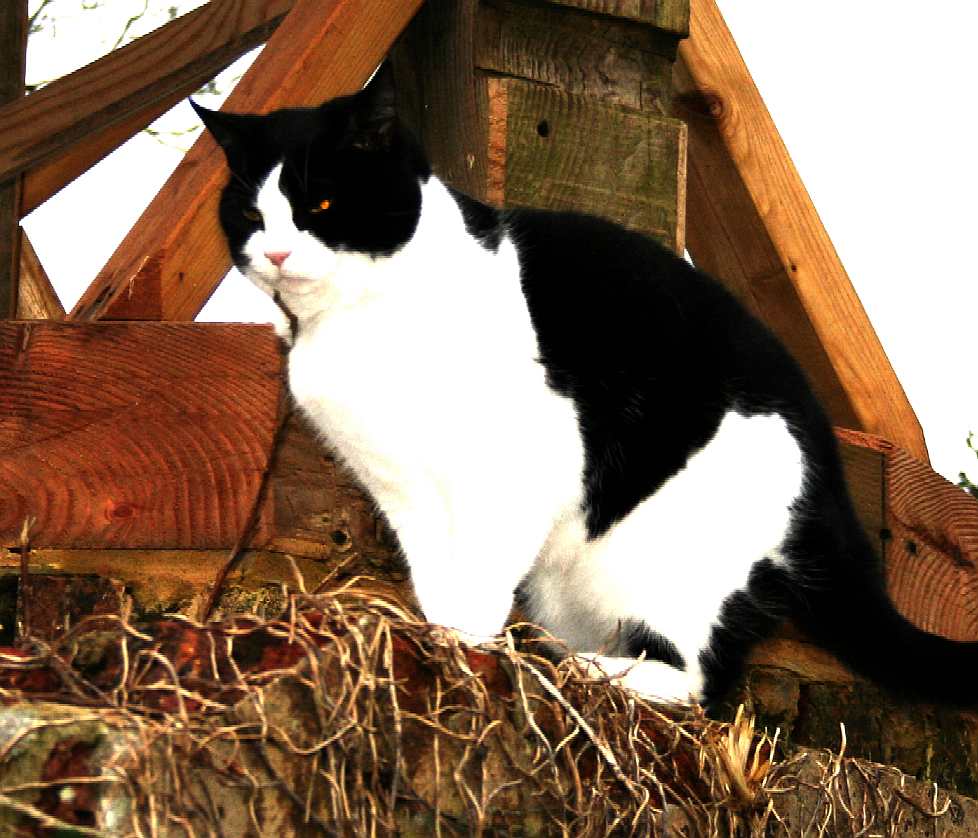
Now
look, we've an inquisitive visitor to the well. No wonder all the mice
have skidaddled. Ding, dong, bell. Who put pussy down the well?
Fortunately, for this curious feline there is a hatch cover to prevent
furry backpackers from involuntarily practicing their freefall diving
skills. Cats hate water.
DING,
DONG, BELL
Ding, dong, bell,
Pussy’s in the well.
Who put her in?
Little Johnny Flynn.
Who pulled her out?
Little Tommy Stout.
What a naughty boy was that,
To try to drown poor pussy cat,
Who ne’er did him any harm,
But killed all the mice in the farmer's barn.
PUSSY
CAT, PUSSY CAT
Pussy cat, pussy cat, where have you been?
I've been to London to look at the Queen.
Pussy cat, pussy cat, what did you do there?
I chased a little mouse right under the chair.
QANATS
A qanat is an ancient water collection system made up of a series of wells and linked underground water channels that collects flowing water from a source usually a distance away, stores it, and then brings the water to the surface using gravity. Much of the population of Iran and other arid countries in Asia and North Africa historically depended upon the water from qanats; the areas of population corresponded closely to the areas where qanats are possible.
In Egypt, shadoofs and sakiehs are used. When compared to each other however, the Sakkieh is much more efficient, as it can bring up water from a depth of 10 metres (versus the 3 metres of the shadoof). The Sakieh is the Egyptian version of the
Noria.
From the Iron Age onwards, wells are common archaeological features, both with wooden shafts and shaft linings made from wickerwork.
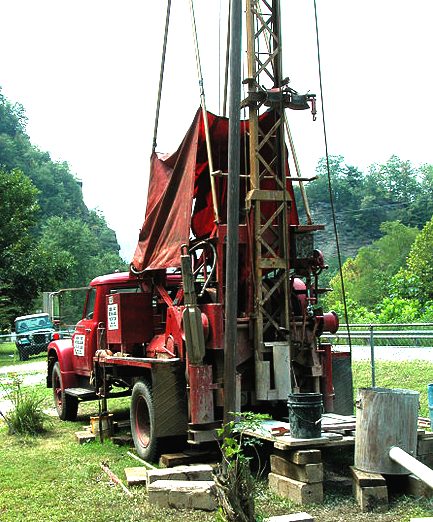
Well
'spudder' truck
DUG WELLS
Until recent centuries, all artificial wells were pumpless hand-dug wells of varying degrees of formality, and they remain a very important source of potable water in some rural developing areas where they are routinely dug and used today. Their indispensability has produced a number of literary references, literal and figurative, to them, including the Christian Bible story of Jesus meeting a woman at Jacob's well (John 4:6) and the "Ding Dong Bell" nursery rhyme about a cat in a well.
Hand-dug wells are excavations with diameters large enough to accommodate one or more persons with shovels digging down to below the water table. They can be lined with laid stones or brick; extending this lining upwards above the ground surface to form a wall around the well serves to reduce both contamination and injuries by falling into the well. A more modern method called caissoning uses reinforced concrete or plain concrete pre-cast well rings that are lowered into the hole. A well-digging team digs under a cutting ring and the well column slowly sinks into the aquifer, whilst protecting the team from collapse of the well bore.
Hand dug wells provide a cheap and low-tech solution to accessing groundwater in rural locations in developing countries, and may be built with a high degree of community participation, or by local entrepreneurs who specialize in hand-dug wells. They have been successfully excavated to 60 metres (200 ft). Hand dug wells are inexpensive and low tech (compared to drilling) as they use mostly hand labour for construction. They have low operational and maintenance costs, in part because water can be extracted by hand bailing, without a pump. The water is often coming from an aquifer or groundwater, and can be easily deepened, which may be necessary if the ground water level drops, by telescoping the lining further down into the aquifer. The yield of existing hand dug wells may be improved by deepening or introducing vertical tunnels or perforated pipes.
Drawbacks to hand-dug wells are numerous. It can be impractical to hand dig wells in areas where hard rock is present, and they can be time-consuming to dig and line even in favourable areas. Because they exploit shallow aquifers, the well may be susceptible to yield fluctuations and possible contamination from surface water, including sewage. Hand dug well construction generally requires the use of a well trained construction team, and the capital investment for equipment such as concrete ring moulds, heavy lifting equipment, well shaft formwork, motorized de-watering pumps, and fuel can be large for people in developing countries. Construction of hand dug wells can be dangerous due to collapse of the well bore, falling objects and asphyxiation, including from dewatering pump exhaust fumes.
Woodingdean well, hand-dug between 1858 and 1862, is claimed to be the world's deepest hand-dug well at 1,285 feet (392 m). The Big Well in Greensburg, Kansas is billed as the world's largest hand-dug well, at 109 feet (33 m) deep and 32 feet (9.8 m) in diameter. However, the Well of Joseph in the Cairo Citadel at 280 feet (85 m) deep and the Pozzo di S. Patrizio (St. Patrick's Well) built in 1527 in Orvieto, Italy, at 61 metres (200 ft) deep by 13 metres (43 ft) wide are both larger by volume.
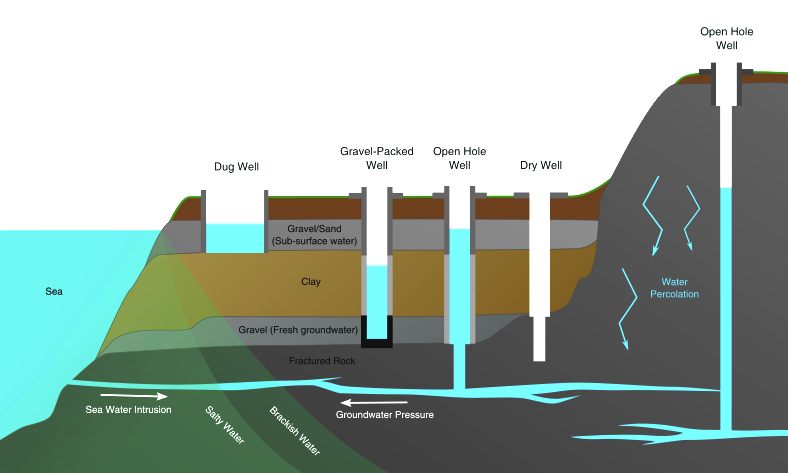
Well,
well, well - types of well
DRILLED WELLS
Drilled wells are typically created using either top-head rotary style, table rotary, or cable tool drilling machines, all of which use drilling stems that are turned to create a cutting action in the formation, hence the term 'drilling'.
Drilled wells can be excavated by simple hand drilling methods (augering, sludging, jetting, driving, hand percussion) or machine drilling (rotary, percussion, down the hole hammer). Deeprock rotary drilling method is most common. Rotary can be used in 90% for formation types.
Drilled wells can get water from a much deeper level than dug wells can - often up to several hundred metres.
Drilled wells with electric pumps are used throughout the world, typically in rural or sparsely populated areas, though many urban areas are supplied partly by municipal wells. Most shallow well drilling machines are mounted on large trucks, trailers, or tracked vehicle carriages. Water wells typically range from 3 to 18 metres (9.8–59 ft) deep, but in some areas can go deeper than 900 metres (3,000 ft).
Rotary drilling machines use a segmented steel drilling string, typically made up of 6 metres (20 ft) sections of galvanized steel tubing that are threaded together, with a bit or other drilling device at the bottom end. Some rotary drilling machines are designed to install (by driving or drilling) a steel casing into the well in conjunction with the drilling of the actual bore hole. Air and/or water is used as a circulation fluid to displace cuttings and cool bits during the drilling. Another form of rotary style drilling, termed 'mud rotary', makes use of a specially made mud, or drilling fluid, which is constantly being altered during the drill so that it can consistently create enough hydraulic pressure to hold the side walls of the bore hole open, regardless of the presence of a casing in the well. Typically, boreholes drilled into solid rock are not cased until after the drilling process is completed, regardless of the machinery used.
The oldest form of drilling machinery is the cable tool, still used today. Specifically designed to raise and lower a bit into the bore hole, the 'spudding' of the drill causes the bit to be raised and dropped onto the bottom of the hole, and the design of the cable causes the bit to twist at approximately ¼ revolution per drop, thereby creating a drilling action. Unlike rotary drilling, cable tool drilling requires the drilling action to be stopped so that the bore hole can be bailed or emptied of drilled cuttings.
Drilled wells are usually cased with a factory-made pipe, typically steel (in air rotary or cable tool drilling) or plastic/PVC (in mud rotary wells, also present in wells drilled into solid rock). The casing is constructed by welding, either chemically or thermally, segments of casing together. If the casing is installed during the drilling, most drills will drive the casing into the ground as the bore hole advances, while some newer machines will actually allow for the casing to be rotated and drilled into the formation in a similar manner as the bit advancing just below. PVC or plastic is typically welded and then lowered into the drilled well, vertically stacked with their ends nested and either glued or splined together. The sections of casing are usually 6 metres (20 ft) or more in length, and 6 to 12 in (15 to 30 cm) in diameter, depending on the intended use of the well and local groundwater conditions.
Surface contamination of wells in the United States is typically controlled by the use of a 'surface seal'. A large hole is drilled to a predetermined depth or to a confining formation (clay or bedrock, for example), and then a smaller hole for the well is completed from that point forward. The well is typically cased from the surface down into the smaller hole with a casing that is the same diameter as that hole. The annular space between the large bore hole and the smaller casing is filled with bentonite clay, concrete, or other sealant material. This creates an impermeable seal from the surface to the next confining layer that keeps contaminants from traveling down the outer sidewalls of the casing or borehole and into the aquifer. In addition, wells are typically capped with either an engineered well cap or seal that vents air through a screen into the well, but keeps insects, small animals, and unauthorized persons from accessing the well.
At the bottom of wells, based on formation, a screening device, filter pack, slotted casing, or open bore hole is left to allow the flow of water into the well. Constructed screens are typically used in unconsolidated formations (sands, gravels, etc.), allowing water and a percentage of the formation to pass through the screen. Allowing some material to pass through creates a large area filter out of the rest of the formation, as the amount of material present to pass into the well slowly decreases and is removed from the well. Rock wells are typically cased with a PVC liner/casing and screen or slotted casing at the bottom, this is mostly present just to keep rocks from entering the pump assembly. Some wells utilize a 'filter pack' method, where an undersized screen or slotted casing is placed inside the well and a filter medium is packed around the screen, between the screen and the borehole or casing. This allows the water to be filtered of unwanted materials before entering the well and pumping zone.
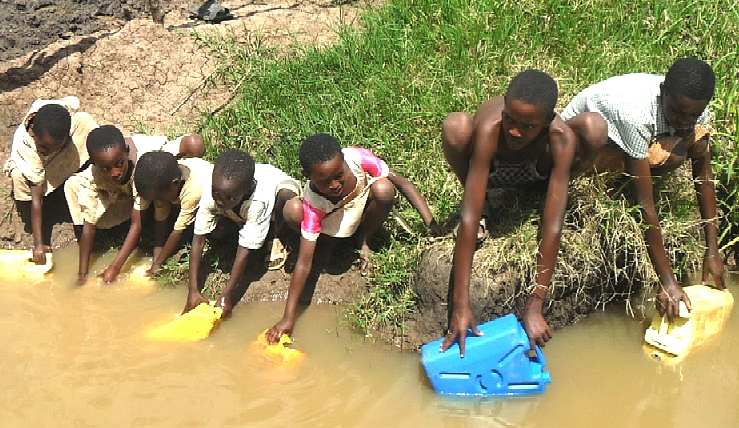
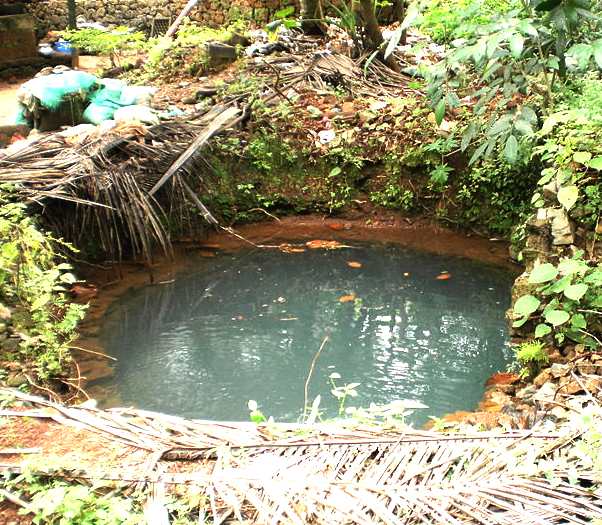
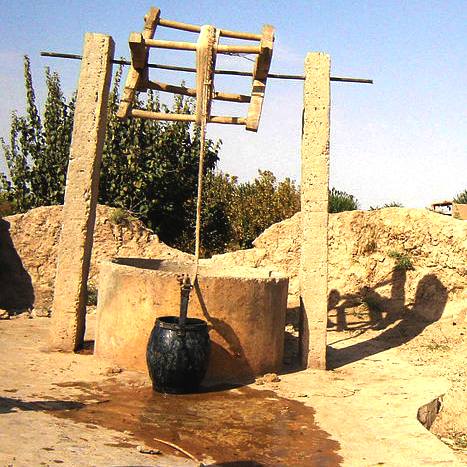
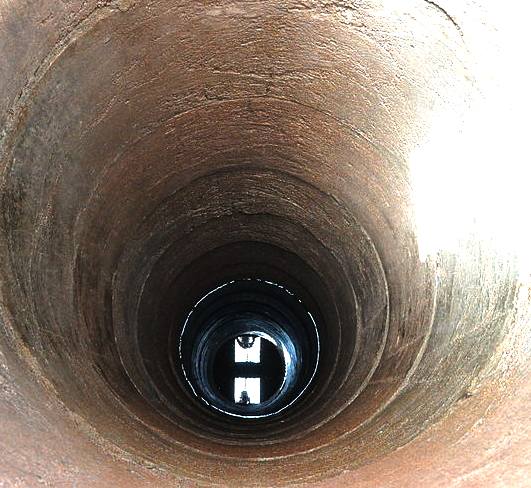
Water
holes from around the world: India, Afghanistan & Africa - we all need water to survive, a basic
ingredient of human life. The methods are different, so are the
container materials, but the need is as old as time itself.
AFFORDABLE |
CLIMATE
| DEVELOPERS
| ECONOMY
| FLOOD
| HISTORY
HOMES |
LADDER | MORALS
| POVERTY
| PROPERTY |
SLAVERY
| SLUMS | WEALTH
|




































